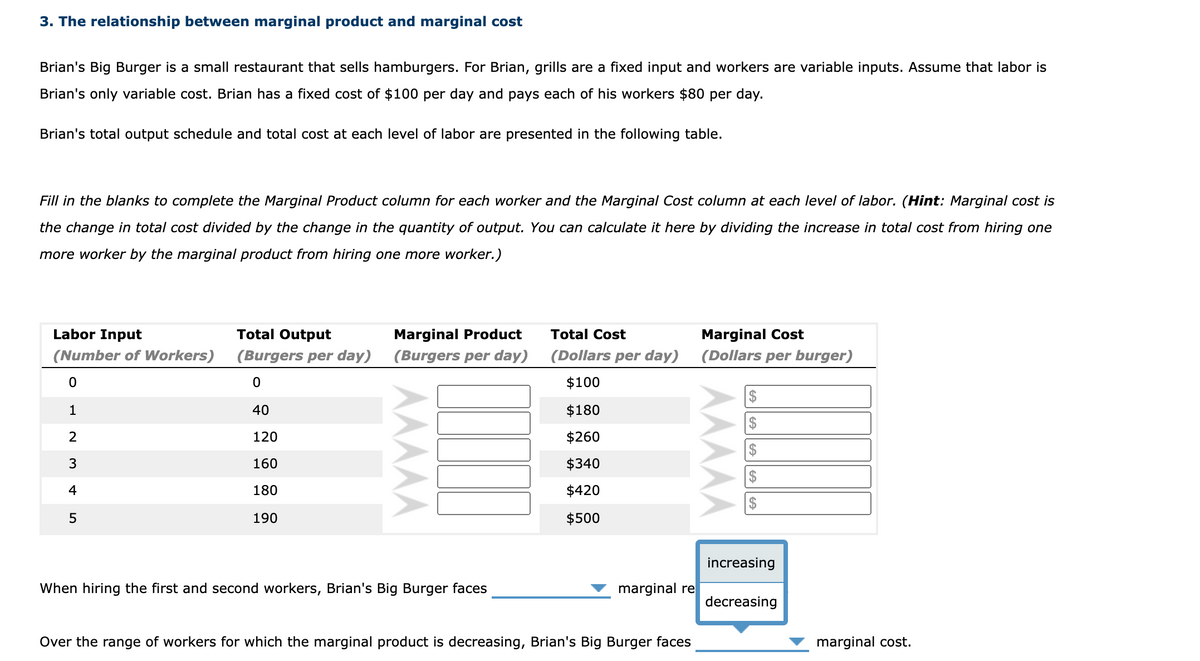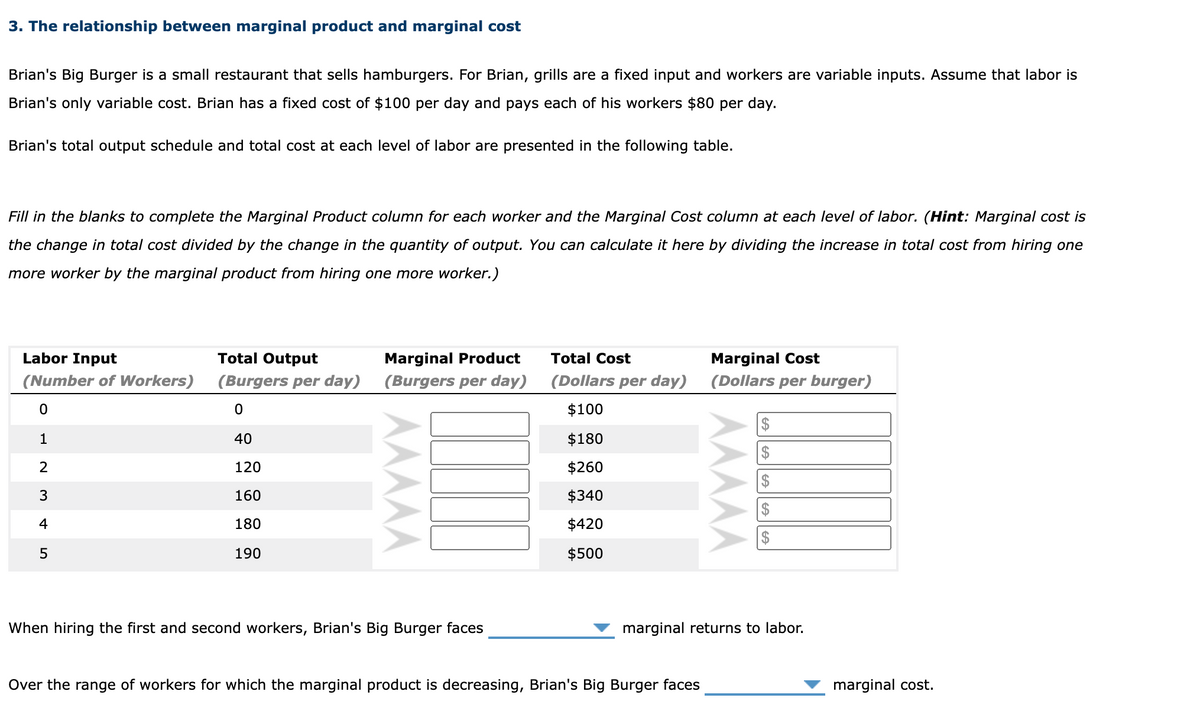3. The relationship between marginal product and marginal cost Brian's Big Burger is a small restaurant that sells hamburgers. For Brian, grills are a fixed input and workers are variable inputs. Assume that labor is Brian's only variable cost. Brian has a fixed cost of $100 per day and pays each of his workers $80 per day. Brian's total output schedule and total cost at each level of labor are presented in the following table. Fill in the blanks to complete the Marginal Product column for each worker and the Marginal Cost column at each level of labor. (Hint: Marginal cost is the change in total cost divided by the change in the quantity of output. You can calculate it here by dividing the increase in total cost from hiring one more worker by the marginal product from hiring one more worker.) Labor Input Total Output Marginal Product (Burgers per day) Total Cost Marginal Cost (Number of Workers) (Burgers per day) (Dollars per day) (Dollars per burger) $100 1. 40 $180 24 2 120 $260 $ 3 160 $340 4 180 $420 190 $500 increasing When hiring the first and second workers, Brian's Big Burger faces marginal re decreasing Ria Rurgor facom marginal coct AAAAA
3. The relationship between marginal product and marginal cost Brian's Big Burger is a small restaurant that sells hamburgers. For Brian, grills are a fixed input and workers are variable inputs. Assume that labor is Brian's only variable cost. Brian has a fixed cost of $100 per day and pays each of his workers $80 per day. Brian's total output schedule and total cost at each level of labor are presented in the following table. Fill in the blanks to complete the Marginal Product column for each worker and the Marginal Cost column at each level of labor. (Hint: Marginal cost is the change in total cost divided by the change in the quantity of output. You can calculate it here by dividing the increase in total cost from hiring one more worker by the marginal product from hiring one more worker.) Labor Input Total Output Marginal Product (Burgers per day) Total Cost Marginal Cost (Number of Workers) (Burgers per day) (Dollars per day) (Dollars per burger) $100 1. 40 $180 24 2 120 $260 $ 3 160 $340 4 180 $420 190 $500 increasing When hiring the first and second workers, Brian's Big Burger faces marginal re decreasing Ria Rurgor facom marginal coct AAAAA
Chapter7: Production And Cost In The Firm
Section: Chapter Questions
Problem 3.7P
Related questions
Question

Transcribed Image Text:3. The relationship between marginal product and marginal cost
Brian's Big Burger is a small restaurant that sells hamburgers. For Brian, grills are a fixed input and workers are variable inputs. Assume that labor is
Brian's only variable cost. Brian has a fixed cost of $100 per day and pays each of his workers $80 per day.
Brian's total output schedule and total cost at each level of labor are presented in the following table.
Fill in the blanks to complete the Marginal Product column for each worker and the Marginal Cost column at each level of labor. (Hint: Marginal cost is
the change in total cost divided by the change in the quantity of output. You can calculate it here by dividing the increase in total cost from hiring one
more worker by the marginal product from hiring one more worker.)
Labor Input
Total Output
Marginal Product
Total Cost
Marginal Cost
(Number of Workers)
(Burgers per day)
(Burgers per day)
(Dollars per day)
(Dollars per burger)
$100
$
1
40
$180
$
2
120
$260
3
160
$340
4
180
$420
190
$500
increasing
When hiring the first and second workers, Brian's Big Burger faces
marginal re
decreasing
Over the range of workers for which the marginal product is decreasing, Brian's Big Burger faces
marginal cost.

Transcribed Image Text:3. The relationship between marginal product and marginal cost
Brian's Big Burger is a small restaurant that sells hamburgers. For Brian, grills are a fixed input and workers are variable inputs. Assume that labor is
Brian's only variable cost. Brian has a fixed cost of $100 per day and pays each of his workers $80 per day.
Brian's total output schedule and total cost at each level of labor are presented in the following table.
Fill in the blanks to complete the Marginal Product column for each worker and the Marginal Cost column at each level of labor. (Hint: Marginal cost is
the change in total cost divided by the change in the quantity of output. You can calculate it here by dividing the increase in total cost from hiring one
more worker by the marginal product from hiring one more worker.)
Labor Input
Total Output
Marginal Product
Total Cost
Marginal Cost
(Number of Workers)
(Burgers per day)
(Burgers per day)
(Dollars per day)
(Dollars per burger)
$100
2$
1
40
$180
2
120
$260
160
$340
4
180
$420
$
190
$500
When hiring the first and second workers, Brian's Big Burger faces
marginal returns to labor.
Over the range of workers for which the marginal product is decreasing, Brian's Big Burger faces
marginal cost.
4|| 4
Expert Solution
This question has been solved!
Explore an expertly crafted, step-by-step solution for a thorough understanding of key concepts.
This is a popular solution!
Trending now
This is a popular solution!
Step by step
Solved in 2 steps

Knowledge Booster
Learn more about
Need a deep-dive on the concept behind this application? Look no further. Learn more about this topic, economics and related others by exploring similar questions and additional content below.Recommended textbooks for you


Essentials of Economics (MindTap Course List)
Economics
ISBN:
9781337091992
Author:
N. Gregory Mankiw
Publisher:
Cengage Learning

Exploring Economics
Economics
ISBN:
9781544336329
Author:
Robert L. Sexton
Publisher:
SAGE Publications, Inc


Essentials of Economics (MindTap Course List)
Economics
ISBN:
9781337091992
Author:
N. Gregory Mankiw
Publisher:
Cengage Learning

Exploring Economics
Economics
ISBN:
9781544336329
Author:
Robert L. Sexton
Publisher:
SAGE Publications, Inc

Principles of Economics (MindTap Course List)
Economics
ISBN:
9781305585126
Author:
N. Gregory Mankiw
Publisher:
Cengage Learning

Principles of Economics, 7th Edition (MindTap Cou…
Economics
ISBN:
9781285165875
Author:
N. Gregory Mankiw
Publisher:
Cengage Learning

Principles of Economics 2e
Economics
ISBN:
9781947172364
Author:
Steven A. Greenlaw; David Shapiro
Publisher:
OpenStax